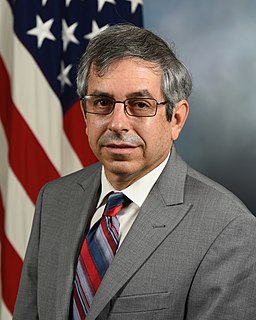Related Research Articles

Jeffrey Alan Hoffman is an American former NASA astronaut and currently a professor of aeronautics and astronautics at MIT.
The MIT Lincoln Laboratory, located in Lexington, Massachusetts, is a United States Department of Defense federally funded research and development center chartered to apply advanced technology to problems of national security. Research and development activities focus on long-term technology development as well as rapid system prototyping and demonstration. Its core competencies are in sensors, integrated sensing, signal processing for information extraction, decision-making support, and communications. These efforts are aligned within ten mission areas. The laboratory also maintains several field sites around the world.

The American Institute of Aeronautics and Astronautics (AIAA) is a professional society for the field of aerospace engineering. The AIAA is the U.S. representative on the International Astronautical Federation and the International Council of the Aeronautical Sciences. In 2015, it had more than 30,000 members among aerospace professionals worldwide.

Norman (Norm) Ralph Augustine is a U.S. aerospace businessman who served as United States Under Secretary of the Army from 1975 to 1977. Augustine served as chairman and CEO of the Lockheed Martin Corporation. He was chairman of the Review of United States Human Space Flight Plans Committee.

The Nanjing University of Aeronautics and Astronautics, colloquially known as Nanhang (南航), is a public research university in Nanjing, China. One of the Seven Sons of National Defence, it is directly supervised by the Ministry of Industry and Information Technology. The university is part of the Project 211 and a Chinese state Double First Class University Plan university identified by the Ministry of Education of China.

Eberhardt Rechtin was an American systems engineer and respected authority in aerospace systems and systems architecture.

Robert Channing Seamans Jr. was an MIT professor who served as NASA Deputy Administrator and 9th United States Secretary of the Air Force.
Mary Louise "Missy" Cummings is an American academic who is a professor at Duke University and director of Duke's Humans and Autonomy Laboratory. She was one of the United States Navy's first female fighter pilots. In November 2021, Dr. Cummings joined the National Highway Traffic Safety Administration (NHTSA).
Nancy G. Leveson is an American specialist in system and software safety and a Professor of Aeronautics and Astronautics at MIT, United States.

Siva Subrahmanyam Banda is an Indian-American aerospace engineer. He is Director of the Control Science Center of Excellence and Chief Scientist for the Aerospace Systems Directorate at the United States Air Force Research Laboratory at Wright-Patterson Air Force Base. He has taught at Wright State University, the University of Dayton, and the Air Force Institute of Technology.

Charbel Farhat is the Vivian Church Hoff Professor of Aircraft Structures in the School of Engineering and the inaugural James and Anna Marie Spilker Chair of the Department of Aeronautics and Astronautics, at Stanford University. He is also Professor of Mechanical Engineering, Professor in the Institute for Computational and Mathematical Engineering, and Director of the Stanford-King Abdulaziz City for Science and Technology Center of Excellence for Aeronautics and Astronautics. He currently serves on the Space Technology Industry-Government-University Roundtable.
Value-driven design (VDD) is a systems engineering strategy based on microeconomics which enables multidisciplinary design optimization. Value-driven design is being developed by the American Institute of Aeronautics and Astronautics, through a program committee of government, industry and academic representatives. In parallel, the U.S. Defense Advanced Research Projects Agency has promulgated an identical strategy, calling it value-centric design, on the F6 Program. At this point, the terms value-driven design and value-centric design are interchangeable. The essence of these strategies is that design choices are made to maximize system value rather than to meet performance requirements.

Edward F. Crawley is a Professor of Aeronautics and Astronautics and of Engineering Systems at Massachusetts Institute of Technology. His teaching and research focuses on Space Systems, Systems Architecture and Systems Engineering. He serves as the co-chair of NASA Exploration Technology Development Program Review Committee and formerly served as the Co-Director of the Gordon Engineering Leadership Program at MIT.

The Purdue University School of Aeronautics and Astronautics is Purdue University's school of aerospace engineering contained within the Purdue University College of Engineering. The school offers BS, M.S., and PhD degrees in aeronautical and astronautical engineering and provides distance graduate education including online MS in Engineering with concentration in Aeronautics and Astronautics and a distance PhD. Its main office and some of its labs are located in the Neil Armstrong Hall of Engineering. As of 2010, the School has awarded an estimated 6% of BS degrees and 7% of PhDs in aerospace engineering in the United States.

Dr. Mark J. Lewis is a senior American aerospace and defense executive with special expertise in hypersonics. He is currently the Executive Director of the National Defense Industrial Association's Emerging Technologies Institute, following his role in the second half of 2020 as the acting US Deputy Under Secretary of Defense for Research and Engineering, and before that the Director of Defense Research and Engineering for Modernization. He was the Chief Scientist of the U.S. Air Force, Washington, D.C. from 2004 to 2008 and was the longest-serving Chief Scientist in Air Force history. He served as chief scientific adviser to the Chief of Staff and Secretary of the Air Force, and provided assessments on a wide range of scientific and technical issues affecting the Air Force mission. In this role he identified and analyzed technical issues and brought them to attention of Air Force leaders, and interacted with other Air Staff principals, operational commanders, combatant commands, acquisition, and science & technology communities to address cross-organizational technical issues and solutions. His primary areas of focus included energy, sustainment, long-range strike technologies, advanced propulsion systems, and workforce development.
Jason Lee Speyer is an American engineer working with mechanical and aerospace engineering currently the Ronald and Valerie Sugar Endowed Professor of Engineering, at University of California, Los Angeles and is also a published author, being held in 860 libraries.

School of Astronautics, HIT is the Engineering school of Harbin Institute of Technology. The school is the first-ever school to initiate college education in astronautics discipline in China.
Karen Elizabeth Willcox is an aerospace engineer and computational scientist best known for her work on reduced-order modeling and the study of multi-fidelity methods. She is currently the director of the Oden Institute for Computational Engineering and Sciences and professor of Aerospace Engineering and Engineering Mechanics at the University of Texas at Austin, Texas.

Mike Gruntman is a physicist, space engineer, and author. He is professor of astronautics and aerospace engineering at the Viterbi School of Engineering, University of Southern California (USC).
The Ann and H.J. Smead Department of Aerospace Engineering Sciences is a department within the College of Engineering & Applied Science at the University of Colorado Boulder, providing aerospace education and research. Housed primarily in the Aerospace Engineering Sciences building on the university's East Campus in Boulder, it awards baccalaureate, masters, and PhD degrees, as well as certificates, graduating approximately 225 students annually. The Ann and H.J. Smead Department of Aerospace Engineering Sciences is ranked 10th in the nation in both undergraduate and graduate aerospace engineering education among public universities by US News & World Report.
References
- ↑ Peterson, Jane A. (2014-11-16). "M.I.T. Settles In for Long Haul in Singapore". The New York Times. ISSN 0362-4331 . Retrieved 2020-06-15.
- ↑ "Daniel E. Hastings". mit.edu. Retrieved April 28, 2017.
- ↑ "Daniel Hastings named the Director of Smart". mit.edu. Retrieved April 28, 2017.
- ↑ "Daniel Hastings named head of Department of Aeronautics and Astronautics". mit.edu. Retrieved June 20, 2018.
- 1 2 Committee on Science, Technology, Engineering, and Mathematics Workforce Needs for the U.S. Department of Defense and the U.S. Defense Industrial Base; Workshop on Science, Technology, Engineering and Mathematics Workforce Needs for the U.S. Department of Defense and the U.S. Defense Industrial Base (Aug 2011 : Rosslyn, VA) (2012). Assuring the U.S. Department of Defense a strong science, technology, engineering, and mathematics (STEM) workforce. Washington, D.C.: National Academies Press. ISBN 978-0-309-26214-9. OCLC 823907497.
- 1 2 3 4 "Nominations to the National Science Board (Text Only)". georgewbush-whitehouse.archives.gov. Retrieved 2020-06-15.
- ↑ Hastings, Daniel E. (1982). "The high‐β universal drift mode". Physics of Fluids. 25 (3): 509. doi:10.1063/1.863763.
- ↑ United States. Congress. Senate. Committee on Health, Education, Labor, and Pensions (2002). Legislative Calendar, One Hundred Seventh Congress. p. 91.
{{cite book}}: CS1 maint: multiple names: authors list (link) - ↑ "Daniel E. Hastings". mit.edu. Retrieved April 9, 2019.
- ↑ "National Academy of Engineering Elects 84 Members and 22 Foreign Members". NAE Website. Retrieved 2020-06-15.
- ↑ "AIAA Fellows" (PDF). 2017. Retrieved 15 June 2020.
- ↑ Hastings, Daniel; Garrett, Henry (2004-08-19). Spacecraft-Environment Interactions. Cambridge University Press. ISBN 978-0-521-60756-8.
- ↑ Ross, Adam M.; Rhodes, Donna H.; Hastings, Daniel E. (2008). "Defining changeability: Reconciling flexibility, adaptability, scalability, modifiability, and robustness for maintaining system lifecycle value". Systems Engineering. 11 (3): 246–262. doi:10.1002/sys.20098. ISSN 1520-6858. S2CID 8722831.
- ↑ Ross, Adam M.; Hastings, Daniel E.; Warmkessel, Joyce M.; Diller, Nathan P. (2004). "Multi-Attribute Tradespace Exploration as Front End for Effective Space System Design". Journal of Spacecraft and Rockets. 41 (1): 20–28. doi:10.2514/1.9204. hdl: 1721.1/84152 . ISSN 0022-4650.